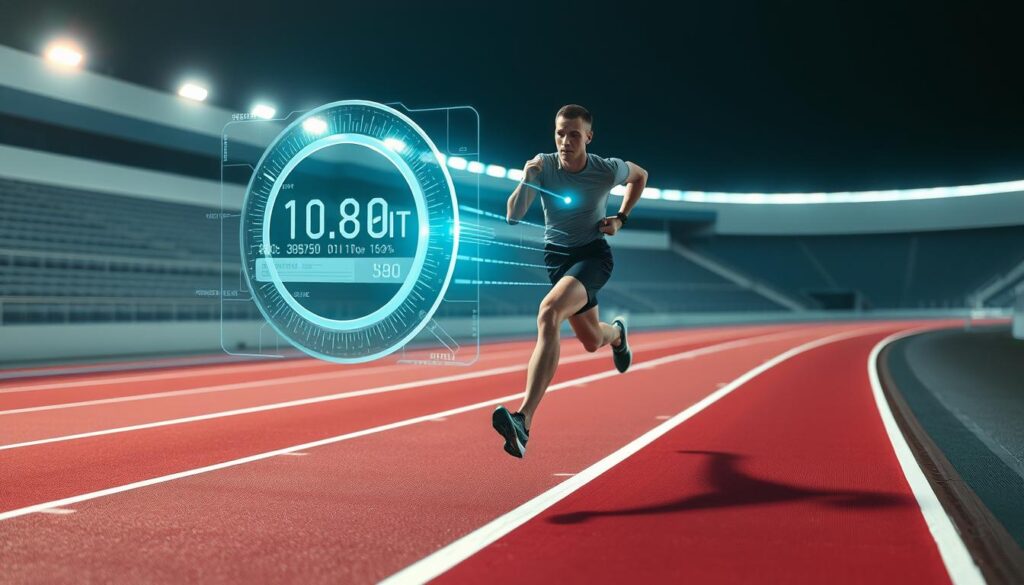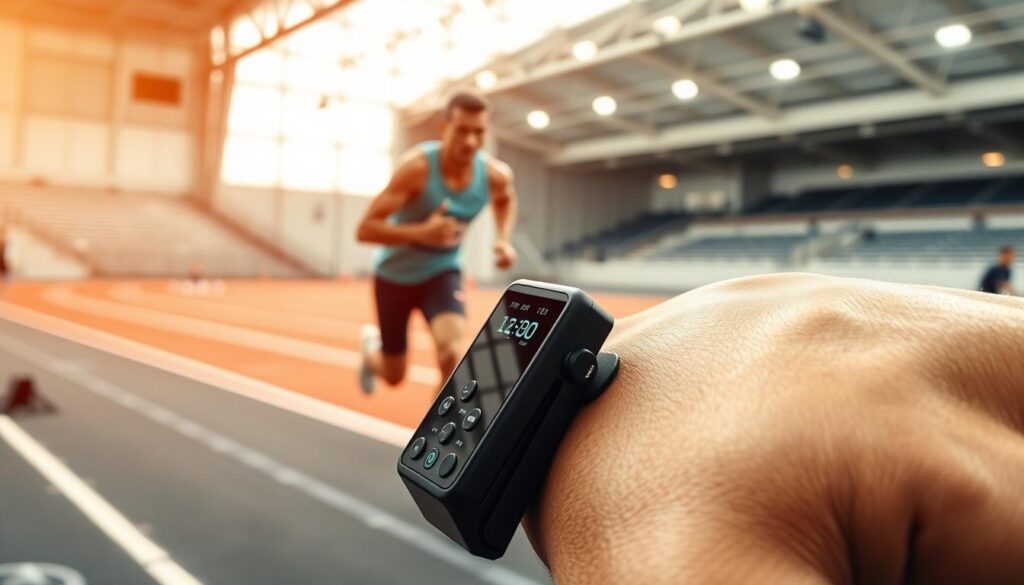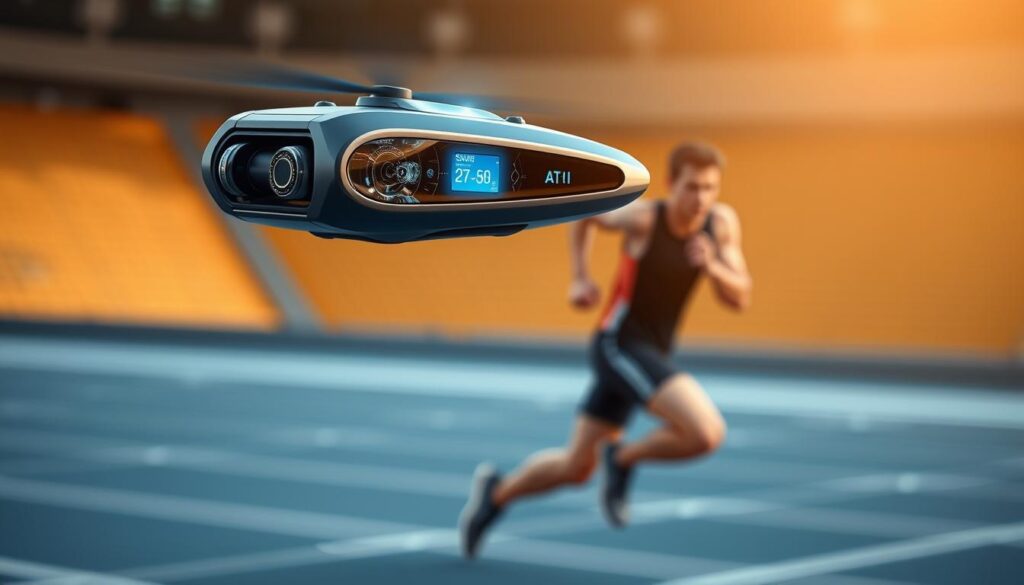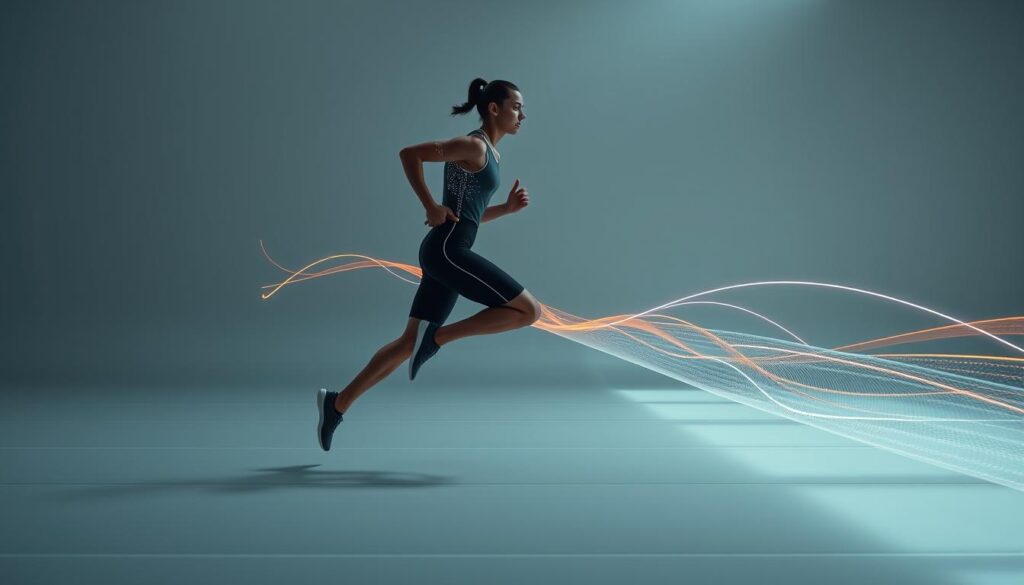One afternoon, a high school coach paused practice when a tablet lit up with real-time data. A starter’s sprint totals dropped and his heart rate stayed high. The coach swapped drills, cut reps, and the player’s recovery improved by the next scrimmage.
This is the kind of instant insight tech now brings to teams. From NFL-grade Catapult GPS vests to WHOOP sleep and HRV tools, and ShotTracker for court work, modern devices turn raw numbers into clear guidance.
We’ll outline AI speed monitor tools, agility performance wearable options, and GPS-based trackers so athletes and coaches can match gear to goals. Expect coverage of metrics like speed, distance, player load, and heart rate, plus recovery cues that shape smarter training and in-game choices.
![]()
Key Takeaways
- Real-time data helps coaches make on-the-spot decisions to protect players.
- Top brands like Catapult and WHOOP bring pro-level insights to schools and clubs.
- Choose between AI speed monitor, GPS trackers, and agility performance wearable types based on sport needs.
- Focus on useful metrics: distance, load, heart rate, and recovery markers.
- Battery life, comfort, and app clarity matter as much as sensor accuracy.
Why wearable sports tracker technology is redefining athlete performance right now
Today’s on-body sensors turn raw numbers into clear guidance that teams can act on immediately.
Coaches, athletes, and parents want simple information: is an athlete ready today, or should they rest? Devices like WHOOP (sleep, HRV, strain) and Garmin Forerunner (VO2 max estimates) make that call clearer. Premier League GPS vests and court systems show live stamina, speed, and positioning so staff can adjust work on the spot.

Accuracy, safety, and usefulness are the top questions families ask. Teams look for clear recovery and heart rate markers that guide when to push and when to ease off. That lowers the chance of injuries while keeping training effective.
- Immediate clarity: real-time data helps coaches make faster decisions about rotations and drills.
- Non-intrusive setup: many wearable devices give positioning and rate checks without slowing practice.
- Privacy basics: leagues and clubs must secure consent and limit who sees player information.
Start simple: track a few key metrics, learn what they mean, then scale features as teams and athletes grow into the tech.
How wearable devices track speed, stamina, and agility
Sensors on the body and in gear work together to turn raw signals into clear training cues coaches can use.

Core sensors explained
Accelerometers measure linear motion and help count steps, accelerations, and sudden starts. Gyroscopes record rotation and direction changes, which reveal cutting and turning patterns.
GPS trackers map outdoor distance and positioning, giving reliable distance splits and field coverage. Heart rate monitors capture effort in real time and link work output to exertion.
From heart rate to HRV
Heart rate shows immediate effort. Heart rate variability (HRV) reveals recovery trends and early fatigue signs.
WHOOP and similar devices use HRV and strain scores to flag when to ease back or push hard.
Real-time capture and training insights
Combined data produce movement patterns: sprint counts, distance covered, and positional heat maps. Catapult blends acceleration, distance, and top runs into a workload number that coaches use to cap sessions.
- Outdoor field work: GPS gives best location and distance accuracy.
- Indoor settings: accelerometer and gyroscope data often outperform GPS.
- Syncing to apps delivers live dashboards so athletes and coaches make instant calls.
Track consistent baselines. That keeps comparisons true and helps athletes spot real gains instead of device variance.
AI speed monitor and real-time coaching feedback
Machine models running on chest and wrist sensors turn noisy readings into trusted insights for training. These systems classify movements, spot shifts in patterns, and give coaches quick, actionable data during practice and games.

Machine learning on the wrist and chest: identifying movements and predicting trends
An AI speed monitor converts raw sensor streams into labeled movements and objective ratings. That lets staff compare a player’s stride, acceleration bursts, and heart rate against age-based norms.
Live decisions in practice and games: pushing, pulling back, and reducing injury risk
Real-time data helps coaches make split-second decisions. When models flag fatigue or a drop in rate, teams can pull a player to cut risk of injuries and aid recovery.
Benchmarking performance over time with objective ratings
Helios is a solid example: its Stride Recognition spots left/right stride quality and benchmarks skill by age without new field hardware.
| Use case | What it flags | Coach action |
|---|---|---|
| Technique drift | Changes in movement patterns | Correct form, shorten session |
| Early fatigue | Decline in acceleration or heart rate consistency | Substitute, reduce reps |
| Skill benchmarking | Objective ratings over time | Set targets, gamify training |
Simple dashboards surface only the day’s key metrics so teams can align fast. Coaches should set clear thresholds (for HRV, rate decline, or symmetry loss) to make consistent, data-driven decisions.
Pick devices and sensors that match the sport and environment so models see clean signals. The goal is straightforward: give each player transparent feedback that improves training and protects their health.
Choosing an agility performance wearable for drills and game-speed training
A simple, reliable device should highlight first-step bursts and direction losses so training stays focused. Pick gear that maps the exact movements that matter for game play. That keeps drills short, clear, and repeatable.
Agility, explosiveness, and change-of-direction metrics that matter
Focus on first-step acceleration, change-of-direction efficiency, and how movement patterns degrade under fatigue. These metrics show where a player loses form and where coaching helps most.
How devices capture game-like drills
Small sensors measure acceleration, rotation, and vertical force during short sprints, shuttles, and jumps. That raw data becomes useful when it is tied to repeatable drills and consistent setups.

Why Hyper Speed stands out in practice
Hyper Speed tracks speed, change-of-direction, and vertical jump with a removable sensor and a real-time app. Setup uses an easy tripod and works at home or on fields. Reviews praise quick setup, youth-friendly bands, and motivating live feedback.
Choosing by comfort, form factor, and decisions
- Prefer wrist or clip-on options that don’t alter running form.
- Pick sensors that detect short sprints, shuttles, and jumps with reliable rep counts.
- Log the same drills so week-to-week gains reflect true improvement, not setup changes.
Keep metrics tight: a small set of clear numbers helps coaches and players make better decisions and spot technique breakdowns before injuries occur.
Spotlight on leading trackers and how teams use them
Here are the standout systems pro and youth teams deploy for clearer session data and smarter recovery.
![]()
Catapult GPS vests
Catapult vests log sprint speed, total distance, and player load. Teams in football, basketball, and soccer use these numbers to set limits on practice intensity.
Coaches balance workloads across players with this data to cut injury risk. The result: clearer session plans and safer training days.
WHOOP bands
WHOOP focuses on sleep, strain, and heart rate variability to guide daily readiness. Athletes and teams use its recovery score to decide whether to push or rest.
For example, a low HRV and high strain often mean a lighter session to reduce fatigue and injury chance.
Helios Core for hockey
Helios Core uses machine learning and Stride Recognition to separate left and right skating strides. It provides age-based benchmarks and gamified progress with no new infrastructure.
Hyper Speed
Hyper Speed captures speed, change metrics, and vertical jump with a removable sensor and a live app. Teams praise fast setup and motivating feedback that keeps players engaged.
| Device | Key metrics | Best fit |
|---|---|---|
| Catapult GPS vests | Sprint speed, distance, total load | Outdoor field sports (football, soccer), basketball |
| WHOOP bands | Sleep, HRV, strain | Recovery-focused tracking for athletes and teams |
| Helios Core | Stride recognition, benchmarks | Hockey and skating programs (zero infra) |
| Hyper Speed | Speed, jump, live feedback | Drill work, agility and jump sessions |
Bottom line: pick devices that match the sport and goals. Teams win when insights are actionable, fit into practice flow, and tie tracking to sleep and recovery habits.
Wearables in action across sports like soccer, football, basketball, and track
Different sports tap specific signals — GPS outdoors, motion sensors indoors — to guide daily decisions. This makes it easier for coaches to manage work, rest, and drills for teams and players.
Soccer and football: positioning, high-volume runs, and stamina
Premier League sides use GPS vests to track positioning and high-speed running volumes. Coaches tally high-intensity efforts so players share load and avoid overwork.
Football programs use distance and acceleration data to balance drills. That reduces injury risk without hurting on-field results.
Basketball: shooting, movement efficiency, and fatigue signals
NBA teams bring ShotTracker into practice to analyze shooting sessions and court positioning. The tool shows which movements lead to better shots and where fatigue shows up late in drills.
Heart rate and recovery cues then guide substitutions or lighter reps when fatigue trends appear mid-practice.
Hockey and running: stride quality, acceleration, and pacing
Helios Core highlights stride patterns on ice so hockey athletes refine acceleration and efficiency. Runners use sensors to pace distance and sharpen interval splits.
Across all fields, pattern analysis uncovers movement inefficiencies that sap late-game speed. Clean GPS outdoors and accelerometers indoors keep data reliable.
- Keep test sets consistent so player comparisons are fair.
- Use simplified dashboards so athletes see clear action steps from complex data.
“Use consistent drills and the right sensors for the setting — that’s how data turns into better choices.”
From data to decisions: optimizing training, recovery, and injury prevention
Smart use of daily numbers helps teams keep training loads steady and recovery strong.
How coaches turn readings into action: rate monitors and HRV guide session intensity. WHOOP’s HRV and strain show readiness, while Catapult’s total load blends distance, acceleration, and rate to manage workload.
Use clear thresholds. When heart rate patterns or HRV drop beyond set limits, coaches adjust drills or cut reps to lower injury risk. Teams like the Seattle Seahawks have tracked sleep to support recovery during long seasons.
Simple process coaches can follow
- Plan: set session goals and thresholds.
- Capture: collect heart rate, HRV, and load each day.
- Review: check trends for fatigue and risk.
- Decide: alter intensity or rest based on insights.
| Metric | What it signals | Coach action |
|---|---|---|
| HRV drop | Poor recovery | Light session, extra sleep focus |
| High strain | Cumulative load | Reduce reps, active recovery |
| Rising heart rate at rest | Onset fatigue or illness | Medical check, lower intensity |
| Back-to-back high loads | Injury risk rises | Insert rest day, monitor closely |
Athlete checklist: warm-up quality, HR/HRV, perceived fatigue, and last session load. Log a short note too — numbers need context. Combining heart rate, HRV, and speed trends gives clearer insights than any single metric.
Privacy, ethics, and ownership: handling athlete data in teams and leagues
Sensitive athlete records can shape careers, so leagues need firm policies on access and use. Clear rules help players trust the system and let staff use information to improve training and health.
Why ownership and consent matter: data should belong to the athlete or be shared only with explicit consent. Teams and leagues must explain who sees what and why.
Contracts, consent, and safeguarding sensitive information
- Ownership & consent: state who owns collected data and require written consent before sharing.
- Safeguarding information: encrypt records, limit access, and separate medical files from coaching dashboards.
- Example risk: if declining performance trends are used to cut a player’s contract, that misuse harms careers and trust.
- Contract clauses: include retention limits, anonymization steps, and deletion at season end.
- Approved uses: allow training, medical care, and rehab, but ban non-consensual scouting or contract decisions.
- Audits & portals: schedule periodic audits and give athletes a portal to view and export their records.
- Staff training: privacy education reduces human error and lowers legal risk.
- Cross-team sharing: leagues should standardize protections so data sharing between clubs is fair and secure.
Build trust: clear communication keeps focus on improving health and sleep metrics rather than policing people. Strong governance encourages athletes to engage with tracking for better outcomes.
| Area | Best practice | Why it matters |
|---|---|---|
| Retention | Define limits and deletion | Protects player careers |
| Anonymization | Use for research or league reports | Reduces legal and ethical risk |
| Access | Role-based permissions | Keeps sensitive information private |
Buying guide: how to pick the best wearable sports tracker for your goals
A buying plan begins by matching the most useful sensors to the sport and session type. Start with what you want to measure and who will use the data daily.
Match features to sport: GPS, sensors, and accuracy
Outdoor field teams should favor GPS-based systems like Catapult for accurate distance and position. For indoor court work, pick devices with strong accelerometer and gyroscope data.
Helios is useful for hockey—benchmarks and gamified progress need no new infra. Hyper Speed gives live drill results with an easy tripod setup for home or field.
App experience: dashboards, benchmarks, and team reporting
Check for real-time dashboards, clear benchmarks, and export options. WHOOP’s app emphasizes readiness, sleep, and HRV for recovery-focused athletes.
Fit, comfort, battery life, and durability for daily training
- Match form factor to movement so gear doesn’t change running or cutting.
- Compare battery life and ruggedness for daily use.
- Choose systems that integrate with team workflows and offer flexible alerts so coaches can use data on the fly.
“Pick the features that change decisions, not the one with the flashiest spec.”
Conclusion
Pro-grade insights are now practical for every team. Catapult’s GPS load, WHOOP’s sleep and HRV readiness, Helios’ stride recognition, and Hyper Speed’s live jump and speed feedback show how data turns into better results for players and coaches.
The payoff is simple: smarter training, safer recovery, and clearer gains in on-field performance. Pick devices that match your environment, start with one priority metric, and use consistent benchmarks to build trust.
Example: pairing GPS load with sleep and HRV helps plan peak weeks with confidence. Athletes across sports like soccer, hockey, and track can access these tools without pro budgets.
Now is the time to align training and recovery before the next big game.
FAQ
What features should I prioritize when choosing a device to track player speed and stamina?
Look for GPS accuracy, reliable accelerometers and gyroscopes, and a chest or wrist sensor that captures heart rate and heart rate variability (HRV). Battery life, comfort, and durability matter for daily training. Also check the app for real-time dashboards, distance and sprint metrics, and team reporting so coaches can turn data into actionable training decisions.
How do these devices measure sprint speed and change-of-direction efforts?
Devices combine GPS for distance and top-end speed with inertial sensors (accelerometers and gyroscopes) to detect acceleration, deceleration, and lateral movement. Algorithms translate those signals into sprint count, peak speed, and agility or change-of-direction metrics coaches use to design drills and reduce injury risk.
What does heart rate variability (HRV) tell me about recovery and fatigue?
HRV reflects autonomic nervous system balance and helps indicate readiness to train. A higher HRV typically signals better recovery and lower fatigue; a lower HRV can warn of strain or illness. Teams use HR and HRV together with load metrics to adjust session intensity and plan recovery strategies like sleep optimization.
Can these systems give useful real-time coaching feedback during games or practice?
Yes. Many setups provide live metrics—like current speed, recent sprint load, and strain—so coaches can make immediate decisions to push or pull players. Real-time alerts help manage workload, prevent overexertion, and reduce injury risk during high-intensity moments.
How do teams protect player privacy and sensitive performance data?
Teams should use clear contracts and informed consent, restrict access to authorized staff, and follow data protection best practices. Encryption, anonymized reports, and retention policies help safeguard information. League rules and collective bargaining agreements can also dictate ownership and use of biometric data.
Do pro-grade systems like Catapult or WHOOP really help lower injury risk?
When used correctly, yes. Catapult-style GPS vests quantify sprint volume and total load, while WHOOP-style bands track sleep, strain, and HRV for recovery planning. Integrating these metrics lets staff balance load across training cycles and spot fatigue trends linked to higher injury risk.
What are the main differences between chest straps and wrist bands for heart rate monitoring?
Chest straps typically provide more consistent heart rate data during high-intensity and rapid movement because they detect electrical signals. Wrist bands are more convenient and track HR trends, HRV, and sleep, but they can be less accurate during explosive efforts. Choose based on your sport and the precision you need.
Can youth athletes and parents benefit from these devices, or are they only for elite teams?
Youth athletes and parents can benefit when devices are used to teach pacing, recovery, and safe progression. For younger players, focus on simple, age-appropriate metrics—distance, perceived effort, and basic HR trends—while ensuring consent and data privacy practices are followed by clubs.
How often should teams benchmark players to track progress over a season?
Regular benchmarking every 4–8 weeks usually works well. Frequent monitoring of sprint speed, distance covered, and HRV provides trend data, while periodic performance tests establish objective ratings for agility, vertical jump, and endurance. Use benchmarks to adjust training blocks and monitor return-to-play.
Will these systems work indoors, like in basketball or hockey arenas where GPS may be unreliable?
Yes. For indoor use, inertial measurement units (IMUs) with accelerometers and gyroscopes excel at capturing movement, acceleration, and change-of-direction. Some solutions add local positioning systems (LPS) or ultra-wideband (UWB) to improve indoor positioning and distance tracking.
How do I match features to my sport: soccer, football, basketball, or track?
Match sensor accuracy and metrics to demands: soccer and football need GPS precision and high-speed running measures; basketball favors movement efficiency, fatigue, and short-burst detection; track benefits from accurate timing and sprint splits. Consider app reporting, battery life, and how teams will use the data in planning and recovery.
What app experience should coaches look for in a system?
Coaches need intuitive real-time dashboards, customizable alerts, historical benchmarks, and team reporting. Look for easy data export, automated reports, and actionable insights that translate raw numbers into training adjustments and individualized recovery plans.
How do these systems help with return-to-play decisions after injury?
They provide objective measures of load tolerance, sprint capacity, and movement symmetry. Comparing pre-injury benchmarks with current outputs helps clinicians and coaches decide when an athlete safely meets performance milestones and reduce re-injury risk during reintegration.
Are there affordable options that still deliver useful insights for amateur teams?
Yes. Lower-cost devices and subscription services offer core metrics—distance, basic speed, HR trends, and HRV—suitable for amateur clubs. Prioritize sensor quality and a clear coaching app. Start with essential metrics and scale up as your staff gains experience interpreting data.
How do teams use distance, sprint counts, and load metrics to plan training and reduce fatigue?
Teams analyze acute versus chronic load ratios, sprint frequency, and total distance to spot spikes that increase injury risk. Coaches then modulate session intensity, prescribe recovery modalities, or alter practice design to balance stress and adaptation across the season.
What role does sleep tracking play in athlete performance management?
Sleep data links directly to recovery, cognitive function, and injury risk. Monitoring sleep duration and quality alongside HRV and strain helps staff set recovery priorities, adjust training loads, and recommend interventions like sleep hygiene or schedule changes to boost readiness.
How reliable are vertical jump and explosiveness measures from modern devices?
Many devices now provide solid vertical jump and power estimates using IMUs or force-sensing peripherals. Accuracy depends on sensor placement and calibration. For consistent longitudinal tracking, use the same device and protocol so coaches can detect real changes over time.
What common pitfalls should teams avoid when implementing a tracking program?
Avoid data overload without staff who can interpret it, inconsistent device wearing, and poor consent processes. Don’t rely solely on raw numbers—combine sensor data with coaching context, wellness questionnaires, and medical input for balanced decisions.
Transform Your IoT Vision Into Reality.
Get free expert insights, architectures & cost breakdowns.
Drop your email to schedule free meeting.